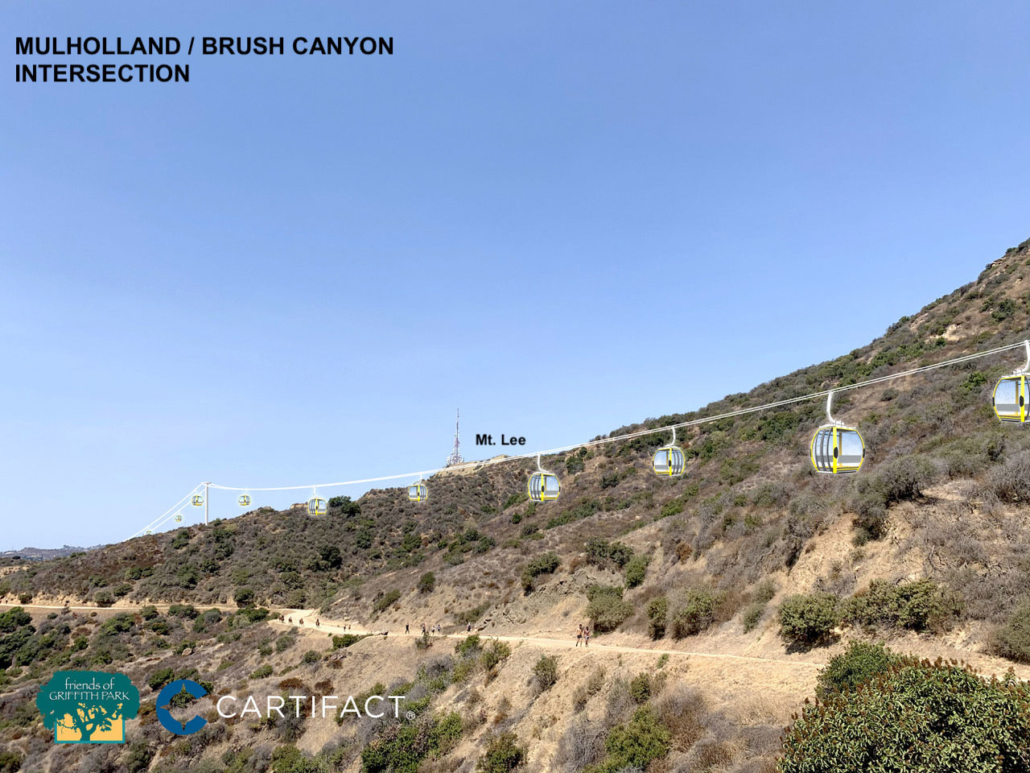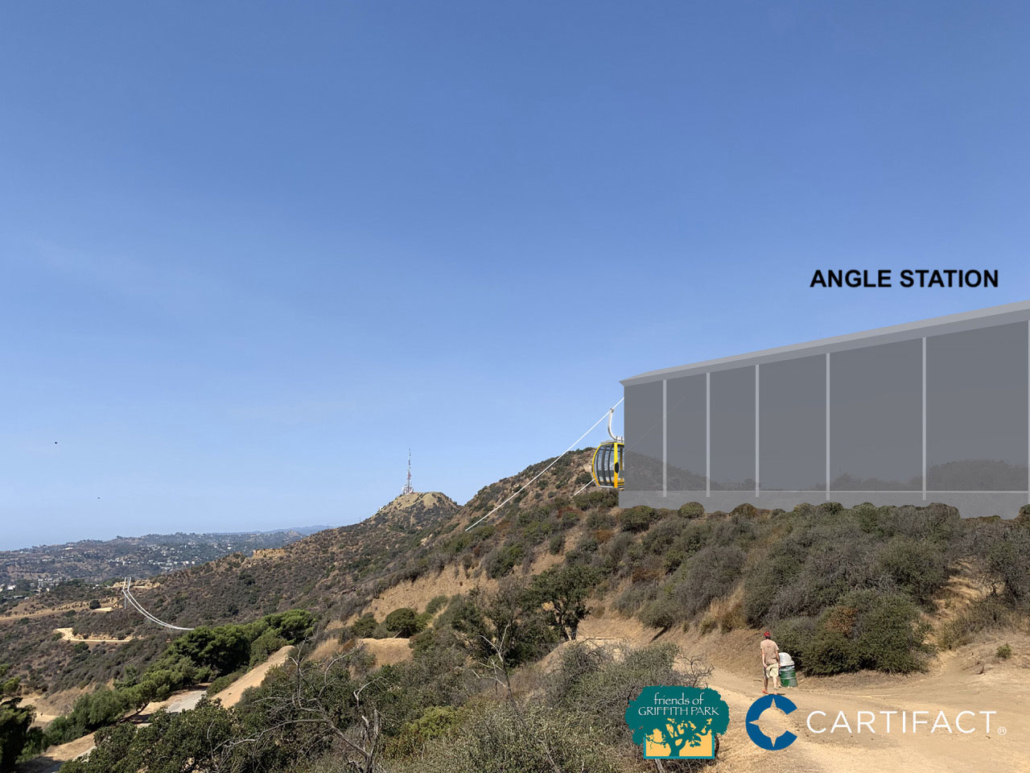Earlier this year, we wrote about the Griffith Park Aerial Tramway, a project that’s been in the works for several years in many different configurations. The plan was already criticized by the Griffith J. Griffith Charitable Trust. Now, the Friends of Griffith Park have joined the ranks, outlining their many good reasons for opposing the project. They have also created their own renderings of the proposed routes for size and scale … and … well, they don’t look very friendly to the park.
When we first wrote about the proposed Griffith Park Aerial Tramway routes, all we had to go on was a slightly blurry photo one of the meeting attendees posted onto Facebook. The Friends of Griffith Park have attended meetings and used measurements and estimates of the scale and scope of this gondola system to render what the supposedly non-invasive system will actually look like in the park.
All four of the proposed routes would adversely affect existing trails. Every route also would destroy an existing Hollywood Sign viewpoint or an actual mountaintop in the park. I’ve already gone over the many trails, viewpoints, and equestrian infrastructure that would be irrevocably lost to this project, but these new renderings illustrate what else would be lost: views, and the character of the park.
The Proposed Routes of the Griffith Park Aerial Tramway
This is a close-up view of the portions of the park that would be affected by the four different proposed routes for the Griffith Park Aerial Tramway. The large black dots are 45-foot tall support towers that would have to be installed. Routes 2 and 3 require the construction of an 8,000 square foot Angle Station. Routes 1, 2, and 3 require the construction of a 20,800 square foot viewing platform.
Route 1 – Travel Town
- Destroys the Martinez Arena equestrian area for parking
- Construction of towers and intrusion into Royce’s Canyon, one of the most remote hiking areas of the park and a known wildlife hotspot
Route 2 – Zoo Station
- Relies on existing Zoo Parking, which is currently at capacity and requesting construction of a new parking structure
- Intrudes on Zoo and golf Driving Range
- Construction of Towers inside Amir’s Garden and Boy’s Camp
Route 3 Zoo Magnet
- Intrudes on Wilson and Harding Golf Courses and crosses the historic Golf Club House
- Requires construction of multiple towers inside Amir’s Garden and Boy’s Camp
Route 4 Warner Brothers
- Requires heavy construction in the largest undisturbed wilderness area of the park
- Includes construction atop Cahuenga Peak, the highest point in the park, and on the popular Eileen Getty Ridge Trail
- Requires construction of new viewing platform beneath the Hollywood Sign on Mount Lee
Renderings of the Griffith Park Aerial Tramway
This is a rendered view of the final stretches of Routes 1 and 2 and is only slightly different from the final stretch of Route 3. A number of 45-foot tall poles will lead the gondola cars parallel to and crossing the Mulholland Trail. The existing Tyrolean tank area — long a popular viewing area for the Hollywood Sign for those willing to hike to it — will be demolished and replaced with 20,800 square foot “corral.” Mount Lee Drive will need to be re-routed and re-graded, and plans require “significant regrading of existing terrain.” It is expected that peak capacity of this area will be 2,000 people per hour.
If you’re hiking or horseback riding along the Mulholland Trail to summit Mount Lee and see the sign — one of the most popular and recommended hiking routes to the Hollywood Sign — you’re going to have this new view. And lots of new neighbors hanging above you.
But perhaps the most egregious alteration of the park’s landscape would be atop the summit of Baby Bell — a peaceful, uncrowded summit in the park’s rugged interior that is well off the beaten path of most visitors. That summit would be entirely lost, replaced by an 8,000 square foot Angle Station to reroute visitors coming in from Routes 1 and 2.
The Griffith Park Aerial Tramway is a Solution in Search of a Problem
Aerial tramways have already been pitched multiple times for use in Griffith Park and so far they have all been shot down. In a piece I wrote called “4 Ideas for Griffith Park that are Better than a Gondola,” I outlined the previous attempts and the many, many shortcomings with this new proposal.
It is clear that someone, somewhere is just trying to find an excuse to build this thing. First it was pitched as a tourist ride from Universal Studios. When they said no, it was pitched as a tourist ride from Warner Brothers. Then it was being justified as a way to reduce traffic in the nearby residential neighborhoods of Hollywoodland — even though shuttles can move far more people and require only the use of paint for new shuttle lanes. Now it’s being touted as a transportation network — even though not a single one of these proposed routes connects with nearby mass transit, making it a car-free system you have to drive to.
Basically, every time they trot out a new justification for doing this, there is a cheaper, easier, less intrusive way to accomplish those supposed goals. There is no construction route for this aerial tramway that does not severely and irrevocably alter the fundamental nature of experiencing one of the very few large, open green spaces in the entire city of Los Angeles. And that’s true whether you’re hiking, horseback riding, golfing, enjoying a visit to Travel Town or the Zoo, or trying to look at the Hollywood Sign from one of the many, many places you can do that. It is a solution in search of a problem.
Unfortunately, L.A. has a really bad track record of destroying existing parks for “convenience” or “entertainment” or “tourist income.” Downtown’s Pershing Square used to be an idyllic tree-lined reprieve from the city. Now it’s a parking lot with a cement plaza on top. Westlake Park was cut in half by Wilshire Boulevard. Elysian Park is similarly bisected by Stadium Way (with no safe crosswalks on the major trails, by the way) and is now home to one of the world’s largest asphalt parking lots. Griffith itself has already lost precious park land to the freeways and a landfill, and we simply cannot let its last remaining slivers of rugged chaparral be lost to short-sighted developers hypnotized by a flashy tourist trap.
40% of Angelenos don’t live within a ten minute walk of even a small neighborhood park, and we’re going to subject our one true open urban wilderness space to construction closures, noise, and destruction? We can do better, L.A. And we need to do better.
What Would Griffith J. Griffith Say?
The park’s donor is generously described as a complicated figure. He had many detestable qualities and attitudes, but he was also genuinely civic-minded and cared passionately about parks. To Griffith, parks were not a luxury afforded only to the wealthy or added on to cities as a bonus — they were a necessity.

Griffith’s book in the rare books room of the Central Library
In his 1910 book Parks, Boulevards, and Playgrounds, you can read his remarkably progressive park philosophy for yourself. He described parks as “the safety valves of cities,” and said that “money wisely spent on them is the best investment any city can make.”
Griffith wrote extensively about what other cities were working toward, noting major cities had “not merely parks, but park systems,” adding:
And I wish to point out particularly that they are proceeding not on artificial, but natural lines; the object sought not being formal promenades, but spacious areas in which the public can lose itself, forgetting for the moment the restrictions of city life and reveling in the largeness of nature.
Griffith was not at all opposed to some development in the park. After all, he did fund both the Greek Theatre and Griffith Observatory and enjoyed the Old L.A. Zoo in his time. But for him, the wild backcountry was the true gem:
I am not at all insensible to the charms of landscape gardening, to trim lawns and floral decorations, which must be defended against vandalism … But I understood clearly that these were not the picture but its frame; that while fitting for the entrance to the people’s playground; that the accessory should not be confused with the thing itself. I had passed months and years scrambling about the heights of Griffith Park, penetrating its lilac-clad canyons and roaming through its river bottoms; and I looked forward eagerly to the day when the health and keen enjoyment they had brought to me should be shared by thousands … (in a place) in which the people may shake off the discipline needed in city life and get, if only for a short time, back to nature.
Is riding in a glass car for a selfie getting back to nature? Is destroying those lilac-clad (ceanothus, really) canyons for an inefficient and unnecessary transit system keeping with the vision of Griffith Park? Is it possible to revel in the largeness of nature while an aerial tramway is inescapable in every view or grinding over your head?
What Can I Do About the Griffith Park Aerial Tramway?
This project is still in the planning phase, and requires many more steps before it becomes a reality. But Griffith Park is always a reflection of those who care most about it, and if you care about maintaining the park’s natural wilderness areas and state as an urban oasis, it is important that you start engaging now and continue being engaged as this process develops.
- Attend a Virtual Event and Fill out the Survey for the Griffith Park Aerial Tramway Study Project. Right now there is no one-click opposition, but you can say you are not interested in any route and give your reasons in the survey.
- Let David Ryu’s Office know this is important to you. The Councilmember represents CD4, which includes Griffith Park. If you live in CD4, your opinion may have more weight, but Councilperson Ryu has said that even if you just visit the park, you are a constituent of the park and he wants to hear from you.
- Let your City and County representatives know you oppose this project, no matter where you live.
- Sign the petition by the Angeles Chapter of the Sierra Club Central Group.
- Stay tuned to the Friends of Griffith Park, and consider joining to support their efforts
- Attend the once-a-month meetings of the Griffith Park Advisory Board
Tags: development, Griffith Park, griffith park aerial tramway





